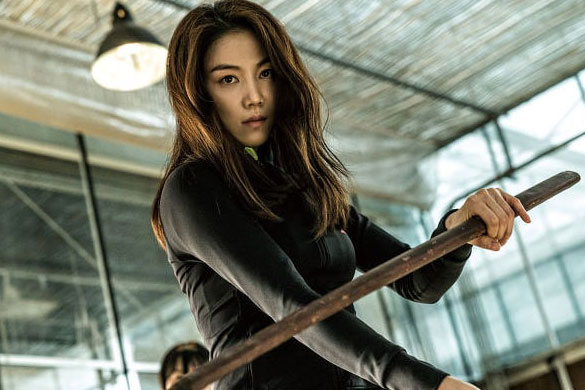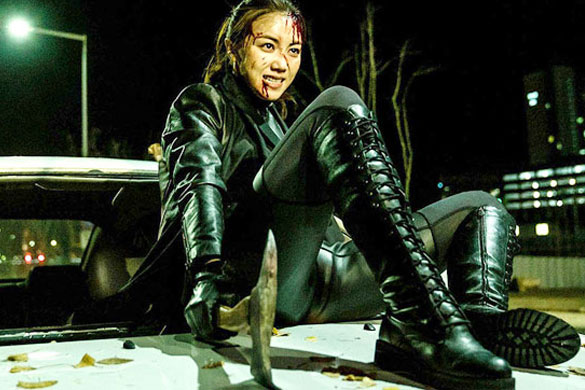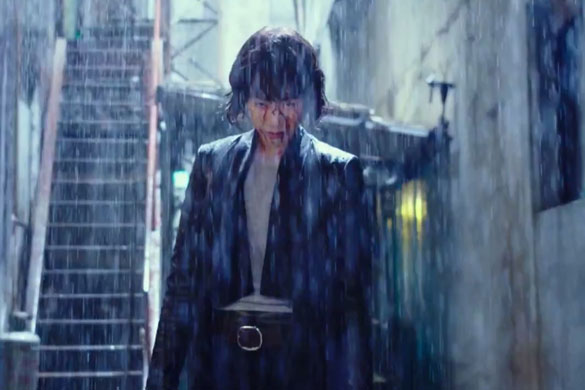"To be or not to be, that is the question. That bitch is also questionable..."
Synopsis:
Having bloodily shot, sliced and diced her way singlehandedly through an entire building of gangsters/meth dealers, leaving not a one standing or indeed breathing, Sook-hee (Kim Ok-bin) is given little option by authorities but to join an elite group of Secret Service assassins; being told if she gives them ten years she'll then be allowed to walk away and live a normal, quiet life. Having been pregnant at the time of her initiation, Sook-hee soon gives birth to a daughter and the decision is taken shortly thereafter to send her out on her first mission under the watchful eye of Hyun-soo (Sung Joon), an agent Sook-hee is led to believe is just a random neighbour.
As the two spend time together, they invariably get closer and gradually move towards beginning a romantic relationship. However, Hyun-soo is unaware that not only has Sook-hee a dark, complex and indeed violent past but she also has an agenda in trying to find the man who killed her father, to take retribution and exact her bloody revenge...
Review:
The Villainess hits the ground running from the very outset as we're thrown headlong into pulse-poundingly violent, blood-spattered scenes (or, considering the amount of blood spilled, perhaps blood-soaked would be a more apt description) of Sook-hee hacking, tearing and bludgeoning her way through thug-filled corridor after stairwell after room. Lasting a full eight minutes before Sook-hee, blood running down her face, exits the building into an alleyway during a torrential downpour to be ‘greeted' by hoards of police (her stern blood-streamed look turning to a manic grin), these scenes are strikingly, intricately choreographed and perfectly enacted to definitively show early on what we'll come to realise is the film's ultimate raison d'être. That is, to provide action that will not just keep you on the edge of your seat but virtually knock you off it. However, I was less enamoured by director Jung Byung-gil's decision to film the first half of these scenes POV-style from Sook-hee’s perspective. To my mind, this at best comes across as a rather overly obvious gimmick the novelty of which quickly wears off and at worst risks leaving viewers feeling they're in the middle of a first-person-shooter video game rather than a vengeful woman's fight to the death. Thankfully, a change to normal perspective does come – brilliantly brought about as a result of Sook-hee's head being smashed into a mirror – allowing viewers to see that the action can and does speak for itself, without the need for angle contrivance.
A frankly insane motorbike battle complete with sword fight and an equally frenetic car chase which sees Sook-hee driving a car ‘pedal to the metal’ while perched outside on the bonnet with an axe are the two other most memorable action set pieces present. In fact, they are the strongest segments of the film as a whole but there is ultimately a downside to this kind of ‘by the seat of your pants' action. That is, that in quieter scenes especially supposedly emotional segments centred on the relationship between Sook-hee and Hyun-soo the narrative slows noticeably to the extent that at times it kind of feels like proceedings have almost ground to a halt. If those relationship scenes had been more effective (more on that shortly) perhaps that would have been less of an issue but a lack of character depth on more than one occasion left me rather itching for the next fast paced action segment – the sections of the film that really work, helped hugely as they are by one of the most perfectly fitting musical soundtracks in recent memory, mixing rock verging on metal with pounding rhythms and even traditional elements in a wholly memorable manner. Jung Byung-gil has stated publicly that the only CGI used in The Villainess was in the removal of wirework cables.
That fact makes the already stunning action sequences and indeed the seemingly endless physicality of both the cast and stunt crew all the more remarkable.
 |
Director Jung Byung-gil on numerous occasions also references other films both Korean and international in The Villainess: A corridor battle during the aforementioned POV sequence that feels eerily similar to the famous and indeed infamous hammer fight scene from Oldboy; repeated channelling of La Femme Nikita – and in one instance an almost copying of a scene in the secret assassin training/sniper mission segments; Sook-hee being pregnant (Kill Bill, anyone?); and even the mirroring of aspects of a scene from Jung Byung-gil's previous film, Confession of Murder, with a main character once again involved in a high speed car chase while positioned on the bonnet of fast moving vehicle.
Jung Byung-gil shall we say ‘borrowed’ in a similar manner in Confession of Murder but while such moves are maybe a bit obvious, I personally didn't have that much of an issue with their inclusion. How you personally feel about their use I guess depends on how much you think they help or hinder the narrative and story overall.
Throughout The Villainess, the present day tale of assassination missions and bloody revenge is interspersed with flashback scenes (almost de rigueur for Korean thrillers of late) gradually unveiling Sook-hee's past. These work well enough when all's said and done, creating an overall story complex enough to be fairly engaging, but what's missing is a much needed depth to Sook-hee's character. Sure, we see her witnessing the murder of her father which ultimately sets her on her path for revenge but we're never shown how the shocking event changed her from who she was or wasn't before.
Why's that important? Well, to my mind, it hits (or should I say misses?) on two levels:
Firstly, in relationship scenes where we need to be able to invest in the character of Sook-hee it rather feels like we hardly know her as a person at all. Add to that the fact that Sook-hee and Hyun-soo constantly lie to each other in either word or by omission (he about being, in truth, an agent who has been tasked with keeping her under surveillance; she about her past) and their relationship can hardly help but feel somewhat fake, more like a quickly written TV series romance than believable cinematic romantic drama scenes.
 |
Secondly, not knowing as much about Sook-hee as a person somewhat affects the film's standing in relation to the female revenge trope in Korean cinema as a whole:
Revenge has long been a major staple of Korean film narratives, having not only been noticeably prevalent for almost as long as references to violence itself but also through the years having served as both its cause and effect. Within the plethora of male-centric 'mano a mano' tales of violent retribution - from 'Oldboy' to 'The Chaser' to 'I Saw the Devil', and all points in between - detailing revenge as a payment in kind of sorts for male brutality, abuse, torture and/or murder of (as often as not, helpless and largely innocent female) characters, there have been regular examples too of women exacting feminine vengeance against specific males, in context, and by extrapolation against the male species in general.
However, though the repeated appearance of these stories of female retribution over the years without question speaks of the gradual shift in place of women in Korean society and the slow, often difficult, move towards balance of the sexes as opposed to traditional patriarchy (and by the same token in each slightly different case serving to underline the gradual change in depictions of female characters in Korean cinema narratives, in the process), it can hardly be denied that - contrary to the majority of stories of male-oriented retribution - in numerous cases female characters taking revenge undertake their vicious quest only after having lost semblance of rationale allowing them to ignore any question of moral right to concentrate on whatever action they feel is warranted (necessary) to exact justice for the wrong they and/or their loved ones suffered. Of course, this isn't always the case (take 'Sympathy for Lady Vengeance' as a contrasting example of a woman who clicks instantly back into normality once her vengeance is successfully concluded) but thrillers such as 'The Housemaid' (1960); 'Diary of June'; 'Princess Aurora'; 'Bedevilled'; 'Azooma' (and the list goes on) or even the endless horror stories of vengeful female ghosts (too many to mention); etc. etc. stand as pointers to the numerous cinematic instances in which the terrible events female characters are subjected to cause an implied yet unmistakable mental trauma and twist leading directly and consequently to utter fanatical obsession with bloody retribution at any and all cost. Whether you agree with the repeated use of these tropes and the often veiled societal implications they bring, almost inherently stated between narrative lines, it can hardly be denied that all of the above examples - and an absolute plethora of others - speak of ongoing issues and even tavesties that continue to be faced by women as they slowly, painfully move towards equality within Korean society. In short, sometimes madness can only be battled by madness.
Ultimately, this thematic prevalence remains, and remains important, regardless of whether you choose to see its continuing appearance as largely a deeply set, repeated - yet often veiled - reiterating of classic Korean Cinema depictions of feminine individuality from as far back as the Golden Age (female outspokenness and indeed sexuality as a destabilising thorn in the side of traditional patriarchal ideals); cite it as part of the gradual shift towards stronger female characters in Korean cinema as a whole, as has been seen in various genres in the last few years; or treat it as simply an eminently useful narrative trope adding societal background, context and even explanation to female violence.
However, in the case of The Villainess, the fact that we only ever so briefly see Sook-hee as a child prior to her father's death and the decision to have the majority of flashback scenes show her being trained - post his death - to become who she in the present is (rather than showing her mental journey or degradation, if you like, from balanced to revenge-obsessed) means that The Villainess is unable to really say anything about female revenge thematically, neither in realtion to ongoing societal issues faced by women in spite of their supposed changing place within Korea as a whole nor indeed in feminism/individuality terms. Sure, Sook-hee is on a vengeance trip but she's a person seeking revenge who just happens to be a woman rather than being a poster girl for female revenge as a trope... and that to my mind is a bit of a shame.
 |
Summary:
While the action set pieces of The Villainess are frankly incredible, a lack of character depth largely prevents the film from saying much thematically. The character of Sook-hee is certainly on a vengeance trip but she's a person seeking revenge who just happens to female, rather than speaking specifically of female revenge in Korean cinema.
THE VILLAINESS (악녀) / 2017 / Directed by Jung Byung-gil
|





